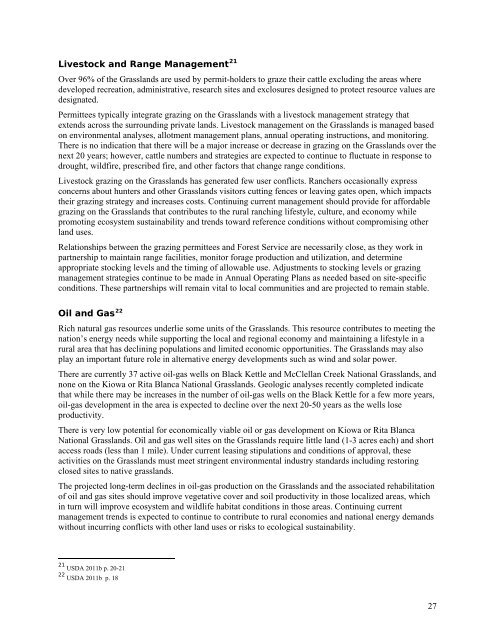Comprehensive Evaluation Report
Comprehensive Evaluation Report
Comprehensive Evaluation Report
Create successful ePaper yourself
Turn your PDF publications into a flip-book with our unique Google optimized e-Paper software.
Livestock and Range Management 21<br />
Over 96% of the Grasslands are used by permit-holders to graze their cattle excluding the areas where<br />
developed recreation, administrative, research sites and exclosures designed to protect resource values are<br />
designated.<br />
Permittees typically integrate grazing on the Grasslands with a livestock management strategy that<br />
extends across the surrounding private lands. Livestock management on the Grasslands is managed based<br />
on environmental analyses, allotment management plans, annual operating instructions, and monitoring.<br />
There is no indication that there will be a major increase or decrease in grazing on the Grasslands over the<br />
next 20 years; however, cattle numbers and strategies are expected to continue to fluctuate in response to<br />
drought, wildfire, prescribed fire, and other factors that change range conditions.<br />
Livestock grazing on the Grasslands has generated few user conflicts. Ranchers occasionally express<br />
concerns about hunters and other Grasslands visitors cutting fences or leaving gates open, which impacts<br />
their grazing strategy and increases costs. Continuing current management should provide for affordable<br />
grazing on the Grasslands that contributes to the rural ranching lifestyle, culture, and economy while<br />
promoting ecosystem sustainability and trends toward reference conditions without compromising other<br />
land uses.<br />
Relationships between the grazing permittees and Forest Service are necessarily close, as they work in<br />
partnership to maintain range facilities, monitor forage production and utilization, and determine<br />
appropriate stocking levels and the timing of allowable use. Adjustments to stocking levels or grazing<br />
management strategies continue to be made in Annual Operating Plans as needed based on site-specific<br />
conditions. These partnerships will remain vital to local communities and are projected to remain stable.<br />
Oil and Gas 22<br />
Rich natural gas resources underlie some units of the Grasslands. This resource contributes to meeting the<br />
nation’s energy needs while supporting the local and regional economy and maintaining a lifestyle in a<br />
rural area that has declining populations and limited economic opportunities. The Grasslands may also<br />
play an important future role in alternative energy developments such as wind and solar power.<br />
There are currently 37 active oil-gas wells on Black Kettle and McClellan Creek National Grasslands, and<br />
none on the Kiowa or Rita Blanca National Grasslands. Geologic analyses recently completed indicate<br />
that while there may be increases in the number of oil-gas wells on the Black Kettle for a few more years,<br />
oil-gas development in the area is expected to decline over the next 20-50 years as the wells lose<br />
productivity.<br />
There is very low potential for economically viable oil or gas development on Kiowa or Rita Blanca<br />
National Grasslands. Oil and gas well sites on the Grasslands require little land (1-3 acres each) and short<br />
access roads (less than 1 mile). Under current leasing stipulations and conditions of approval, these<br />
activities on the Grasslands must meet stringent environmental industry standards including restoring<br />
closed sites to native grasslands.<br />
The projected long-term declines in oil-gas production on the Grasslands and the associated rehabilitation<br />
of oil and gas sites should improve vegetative cover and soil productivity in those localized areas, which<br />
in turn will improve ecosystem and wildlife habitat conditions in those areas. Continuing current<br />
management trends is expected to continue to contribute to rural economies and national energy demands<br />
without incurring conflicts with other land uses or risks to ecological sustainability.<br />
21<br />
USDA 2011b p. 20-21<br />
22<br />
USDA 2011b p. 18<br />
27
















